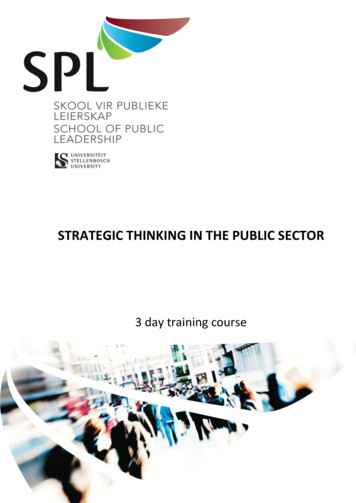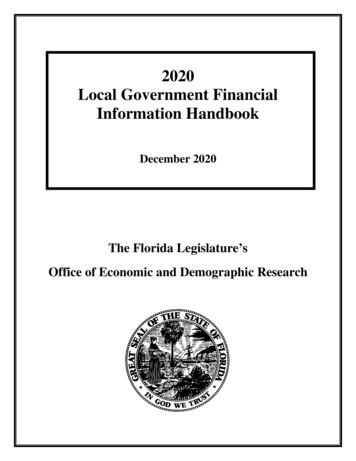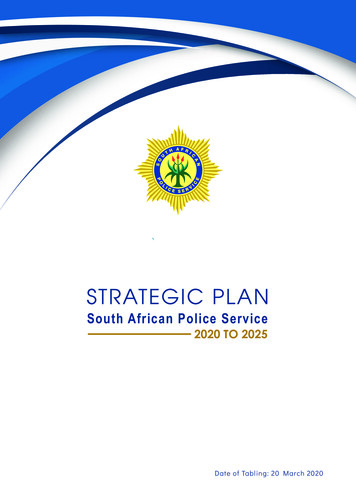
Transcription
OFFICEOF THENEW YORK STATE COMPTROLLERDIVISION OFLOCAL GOVERNMENT AND SCHOOL ACCOUNTABILITYLOCA L GOV ER NMENT M A NAGEMENT GUIDESTRATEGIC PLANNINGThomas P. DiNapoli
Original Issue DateAUGUST 2002Issue DateMAY 2003
Table of ContentsIntroduction . 1Overview . 1Sample Strategic Planning Key Elements . 3Part I – Strategic Planning: What is it? . 7Is Strategic Planning Really for Us?Why do we need a strategic plan? . 8Who to involve . 9Readiness . 10Strategic Planning FundamentalsWhat is strategic planning? . 14Basic Elements of Strategic Planning . 15Part II – Strategic Planning: A How-to Guide . 18Getting OrganizedThe Strategic Planning Team . 19Organizing the Planning Effort . 20The Strategic Planning Process . 20Agree on a Strategic Planning ProcessWhere are we now? . 21Where do we want to be in the future? . 22How do we get there? . 24How do we gauge progress?. 25Putting it all Together – The Strategic PlanWho or which part of the organization is it for? . 29How will it be organized? . 29What will our communication strategies be? . 29Developing Elements of the Strategic PlanMission Statement . 30Vision Statement . 31Goals . 31Objectives . 32Strategies . 33
Application ApproachesThe Basics Do Stay the Same . 34Challenges and Solutions . 35Monitoring via Performance MeasurementWhat should be evaluated and measured . 36How often should you measure? . 37Who should measure? . 37How to measure . 38Some Advice . 39Conclusion . 39Part III – AppendicesA. Definitions . 40B. Tools of the Trade – Working with People . 42 Teams Brainstorming Affinity Diagram Consensus Prioritization SWOT AnalysisC. Considerations for Internal Assessments . 48D. Checklist . 49E. Sample Forms.51 Mission, Values and Vision . 52 Environmental Scans (Internal and External) . 53 Identifying Stakeholders and Customers . 55 Goals and Affected Customers and Stakeholders . 57 Action Plans: Getting from Here to There . 58F. Additional Information . 59 Publications Articles Web Sites MiscellaneousCentral Office Listing. 62Regional Office Listing . 63
Strategic PlanningIntroductionYou’re probably a strategic planning veteran and don’t even know it. Think about it:family vacations, retirement funds, sending your children or yourself to college, theseare all examples of events that required some degree of long-term planning. And that’sexactly the essence of strategic planning: a long-term, usually multi-year, roadmapcomprised of a set of goals and objectives that help you successfully move forwardfrom where you are now to where you want to be.A strategic plan is founded on a vision and continues long after the initial groundwork isset. It’s a common sense tool that sets a clear path for the future, while also allowingfor your vision to mature and change as time passes.Strategic planning is also a preventative measure designed to assist you in achievingmaximum effectiveness and equity before a program or department reaches crisis level.Or, in management terms, strategic planning is “proactive,” instead of “reactive.” Semantics aside, strategic planning translates into good, common sense.You may be following all the principals but not formalizing your plans in a structuredformat for all to see and follow. By formalizing a plan and having input from theparticipants and stakeholders, you are more apt to get buy in from all concerned. In thismanner, a strategic plan is more apt to be successful. To help you and your municipalitybetter understand the mechanics of strategic planning, we offer a fictional account of amunicipality involved in the strategic planning process on pages 3-6. We take youthrough each phase of the strategic plan and explain why certain choices were madeand what steps the planners should take at various points along the way. It is our goal,that after reading the sample strategic plans, you will realize that applying the strategicplanning process to your particular municipal project will assist in its successfulcompletion.With these in mind, it’s time to take your strategic planning expertise to your locality.OverviewStrategic planning is more than just good business, it’s good practice. If done correctly,it has the power to transform today’s visions into tomorrow’s realities. But what exactlyis it? Strategic planning helps your local government realize its long-term vision bysetting up goals and objectives in a systematic, incremental manner. Simply put, itmakes you take a look at what’s going on today, where you want to be tomorrow andwhich steps you will need to take to get there.While strategic planning is a valuable tool that assists all sizes of government plan forthe future, it must be emphasized that the process is only as strong as its advocates.Specifically, strategic planning may only succeed if it has the unequivocal support of thechief executive, legislative body and affected department heads.Strategic Planning - 1
To garner top-level support, hold a meeting or brainstorming session that allows executives and department heads to ask questions, make suggestions and discuss theirconcerns. By bringing these issues to the table, you can show how each item may beenhanced or better served through strategic planning.We have divided this module into two distinct, but complimentary, parts. The firstsection gives you a more theoretical explanation of what strategic planning is. It helpsyou gauge whether your municipality is ready to undertake a project of this nature byillustrating basic principles and concepts. The next section is a “How-To” guide thattakes the theory and puts it into practice. This particular part has been designedspecifically for municipal officials who want to be able to implement strategic planning,but have little to no prior experience.Another facet of the “How-To” section is to provide you with actual forms that your localgovernment may use if it decides to engage in strategic planning. We have also brokendown each chapter within this section so that you and your colleagues can easily reference what you have accomplished, as well as what lies ahead. We created this to be apractical guide that serves as the roadmap for your strategic planning efforts.On the next few pages is a brief example of the strategic planning process that illustrates which key elements are needed for implementation and offers you a guide tofollow in your own locality.Our goal in creating this module is to provide you with another tool that will assist you inyour daily and long-term municipal operations.We have designed this publication for both elected and appointed local officials who areinterested in strategic planning. This guide assumes no prior knowledge of strategicplanning and takes a very basic approach to the rudiments involved in creating andimplementing such a strategic plan.This publication aims to convey the following: Description of strategic planning: what it is, key terms and concepts Why strategic planning is beneficial How to apply this technique Who should be involved, and at which stages Offer a “how-to” guide that takes you from inception to implementationThe Office of the State Comptroller advocates strategic planning as another tool topreserve your municipality’s fiscal health and overall well-being. By taking a look at thepast and present, we believe that you will be better equipped to craft your own future.2 - Chapter 16: Local Government Management Guide
Throughout this chapter, we will further explore the benefits and challenges to implementing strategic planning. Our goal in creating it is to offer you another tool that canassist you with both your daily, as well as long-term, duties. We believe that you willfind this guide to be accessible, and we encourage you to adapt these basic principlesin a manner that will help you and your locality effectively carry out its mission.Strategic Planning has also been designed to compliment other chapters of this guide.For example, Financial Condition discusses capital planning, another type of long-rangeplanning that is built upon forward-looking principles and procedures. Other goodresources include Annual Budgets, Multi-Year Capital Plans, Reserves and DebtManagement.Sample Strategic Plan Key ElementsThe fictitious scenario below takes you through the Strategic Planning process andoffers examples and organizational techniques for you to follow.Background: The City of Townville, population 70,000, has experienced a crime waveover the past year. Loitering, graffiti, stolen property and other minor, but nevertheless,illegal acts have been reported. Understandably, everyone wants to eliminate crime,but since Townville is a small city, there are only so many police officers. In the meantime, the Mayor, City Council and Police Commissioner have been barraged by callsfrom concerned residents and local media regarding the current state of affairs.As City Manager, you believe that you have a solution: community assistance. Byincreasing the number of people walking Townville’s streets, you feel that it will helpdeter crime. In addition, it would heighten community involvement and build moraleand trust. The citizens would work in conjunction with the police department and serveas neighborhood monitors. The question now is: how do we do this?To get a sense if this project is right for Townville, you’ve had to do some homework.You’ve researched how other municipalities have utilized community patrols by readingarticles, accessing websites and interviewing public officials who have had success withthis. After investigating the legal ramifications, meeting with police personnel and unionrepresentatives, crunching numbers, taking an inventory of Townville’s resources andthen garnering support from the Mayor, Council and Police Commissioner, you areready to implement the City of Townville’s first Community Safety Unit. On the followingpage is Townville’s Strategic Plan for the Police Department’s Community Safety Unitfrom start to finish:Strategic Planning - 3
For (department, program or unit): Police Department’s Community Safety Unit,The City of TownvilleStart date:January 1 (beginning of the City of Townville’s fiscal year [FY]Mission Statement:“The City of Townville’s Community Safety Unit is a cooperative effort between the citizens of Townville and its Police Department that strives to keepthe municipality free of illegal and unwarranted activity. The CommunitySafety Unit ensures equality for all persons who either live or visit our areaand promotes integrity, honesty and a sense of community pride. Under thedirection of the Mayor, City Council, Police Chief and a Citizen President, theCommunity Safety Unit and its members are charged with maintaining thehigh quality of life that the people of Townville so deserve.”ValuesThe Community Safety Unit operates under these core beliefs: Partnership: a safe community rests both with the government and itspeople. We encourage and value our residents and their contributions andseek to maintain the alliance. Equality: equal treatment for all people is paramount. We will not toleratediscrimination toward any resident or non-resident and aim to protect therights of all people within our boarders. Integrity: we vow to operate in an ethical and responsible manner and execute the duties of the Community Safety Unit in the same way.Vision Statement:“The City of Townville’s Community Safety Unit would like to expand itspersonnel and services, such as outreach and assistance, while alsomaintaining fiscal integrity and responsibility. We would like to increasevolunteer activities and opportunities and make every member of thecommunity aware of our presence and the many free services that we offer.Townville’s Community Safety Unit seeks to achieve this vision by fiscal year2007.”4 - Chapter 16: Local Government Management Guide
Goals, Objectives and StrategiesGOALOBJECTIVESTRATEGY1. Create volunteer pool toprovide more citizen safetyEstablish Community WatchFoot Patrol in 60% of alldistrictsInitiate foot patrol coverage in60% of all districts at end ofFY2. Offer services responsiveto citizens' needsDiscontinue non-valueservices and replace withnew-value servicesConduct customer survey andimplement at least one newservice by end of 2nd quarterbased on customer survey3. Increase citizen awarenessof Community Safety UnitIncrease Unit's visabilityamong citizensCreate Issue #1 of bi-annualnewsletter and mail toresidents by end of 2ndquarterAction Plans Goal, Objective & Strategy 1: a) Initiate Foot Patrol coverage to 60 percentof all City districts by the end of the fiscal year (December 31).StrategyBy WhomBy WhenRecruit and train newmembersCommunity Safety UnitTraining DivisionNovember 1Initiate coverage for DistrictsA, B and CStrategic Planning WorkGroup #1December 31 (or before)Deploy personnelCommunity Safety UnitDecember 31 (or before)(continued on following page)Strategic Planning - 5
Goal, Objective & Strategy 2: Discontinue outdated services and implement atleast one new service by end of the second quarter (June 30).StrategyBy WhomBy WhenCreate customer surveyTownville Strategic Planning Teamand Community Safety Unit heads(not on Team)End of JanuaryDisseminate surveyAll Townville residentsFebruary 7Compile survey resultsTownville Strategic Planning WorkGroup #2March 15Present findings to Mayor, CityCouncil, Community Safety Unit,public and mediaStrategic Planning Team Leader(e.g., CFO)April 1 (at regularly scheduledcouncil meeting)Agree upon which outdatedservices should be discontinued;create new programsTownville Strategic PlanningTeam and Community Safety Unitheads (not on Team)May 1Publicize new servicesTownville Strategic Planning Workgroup #2June 30Implement new service(s)Community Safety UnitJuly 1 Goal, Objective & Strategy 3: Increase community awareness andvisibility by creating Issue #1 of bi-annual newsletter by the end of secondquarter (June 30).StrategyBy WhomBy WhenCreate Customer survey to gaugedegree of awarenessTownville Strategic Planning Team andCommunity Safety Unit heads (not on team)End of JanuaryDisseminate surveyAll Townwide residentsFebruary 7 (sendwith, or on, CSUservices survey)Compile results and draft a 2-pageself-mailing newsletter (Issue #1)Townville Strategic Planning Work group #3 andCity Public Information OfficeApril 15Review Issue #1Townville Strategic Planning Team andCommunity Safety Unit heads (not on team)May 15Edit and print Issue #1Townville Strategic Planning Work group #3 andCity Public Information OfficeJune 15Disseminate Issue #1Townville Strategic Planning Work group #3 andCity Public Information OfficeJune 30MonitoringFrom this point on, you should be monitoring progress and making coursecorrections, if necessary. If you are meeting your targets and deadlines, chancesare you will have little difficulty meeting your initial objectives.6 - Chapter 16: Local Government Management Guide
Part 1Strategic Planning:What is it?Strategic Planning - 7
Is Strategic Planning for Us?Why Do We Need a Strategic Plan?Inevitably you will have to answer, “Why do we need a strategic plan?” to yourself, yourcolleagues, elected officials or possibly the public. Some may see it as yet anothersoon-to-pass management fad, complete with trendy jargon, increased paperwork andan intensified workload. Others may see it as a challenge to their existing roles and feelthat this “strategic plan,” devalues their prior contributions. While there may still beothers who, no matter what you say on behalf of strategic planning, will not embracechange. The size of the government should dictate the need and degree of implementation. The final decision should be based on cost-benefit.So, why do you need a strategic plan? Strategic planning yields results: A strategic plan provides a realistic,workable framework that is built upon a foundation of constant improvement.Built into the plan are milestones that help gauge your progress. Strategic planning is an invaluable managerial tool: Balancing daily andlong-term operations with defined, and often limited, resources is complex. Astrategic plan assists you in determining how to perform work more efficientlyand effectively, while staying within financial parameters. Strategic planning is adaptable to a changing environment: A multi-yearplan will, inevitably,be affected by the changing internal and external environments. Therefore, you need to have a framework that is flexible enough toaccommodate flux, while at the same time, strong enough to adhere to yourbasic mission and objectives. A strategic plan has those capabilities. Strategic planning is responsive to citizens’ needs: A successful strategic plan includes those priorities that are important to the citizens. Becausecitizen input is a vital component in the process, the ability of the strategicplan to address their needs is great. Strategic planning narrows the communication gap: Dialogue among allof the affected parties ensures a narrowing of potential communication gaps.As said, strategic planning is a participatory tool that cannot function unlessthere is a two-way, open exchange of ideas. Custom-tailored: Each department or municipality has different needs andthe strategic plan allows for specific objectives and parameters that arespecialized and appropriate to the organization. Adaptability: Elements contained within a strategic plan are not “carved instone” and do not end once specific objectives and goals are put on paper.8 - Chapter 16: Local Government Management Guide
It’s an on-going process that is designed to be refined based on changinginternal and external conditions. Accountability: With government dollars shrinking and public sentimentadvocating more fiscal prudence, a solid strategic plan with definite objectives, financial targets and monitoring tools in place, ensures accountability. Participatory: A good strategic plan involves people at all levels ofgovernment, or within the department, and requires input from everyone if it isto succeed. By involving more people among the various levels, you arefostering teamwork and a sense of ownership. The strategic planningprocess should involve the public, as well. In fact, organizations thatsuccessfully implement this solicit input from their customers. Public forums,surveys and task forces are just a few ways that a community can involveresidents. Similar to what you and your colleagues may experience, thisprocess will also allow the public to feel a sense of ownership.A high-quality strategic plan translates into much more than just a written outline of thefuture. A host of practical and subtle benefits also stem from the document. On thepractical, day-to-day side, a strategic plan, by virtue of its structure, has the ability toenhance efficiency, effectiveness and decision-making. On the more subtle side, asuccessful strategic plan that has been crafted by a number of stakeholders has theability to unify and empower a group to enact meaningful change.In addition to these functional elements, a strategic plan is a tangible reflection ofcommunity spirit and culture. The goals and objectives you put on paper arerepresentative of numerous people: staff, local officials, citizens (including taxpayers)and non-residents who may use your public service(s). It also conveys yourcommunity’s values and reinforces the reciprocal partnership that government has to itscitizens. In short, the strategic plan articulates those issues that are important to yourcommunity and allows a collective action plan to come to fruition.Who to InvolveAt each stage of the process, you will need to involve various people and groups.While collectively, everyone’s input is needed, it is important to note that some individuals’ involvement will be limited or sporadic. In terms of readiness, however, you willneed to involve more top-level people at the very beginning.Strategic Planning - 9
In order to become “ready,” you will have to organize the “Strategic Planning Team.”A strategic planning team is the human foundation of the entire project and serves asthe sponsor for the plan. Members of this team generally include: Chief Executive Officer and/or Legislative Body (usually the lead sponsor)Fiscal OfficerLegislative members who have a vested interestKey Department headsSome key stakeholders (suggested stakeholders may include: organizations,groups, customers, vendors)This is really the only formal “team” that you will have. As we will explain later, theothers that will be involved in the strategic planning process will be assigned to “workgroups.” While the work groups will have sporadic involvement at various stages, theyare still just as vital as the strategic planning team.ReadinessBefore you begin formulating a strategic plan, it’s important to ask a few significantquestions that will help in assessing your local government’s degree of readiness.Pre-flight checklist: Is there executive-level support?Is there governing board support?Are we in a favorable position to undertake strategic planning, or are we ata crisis level?Is there departmental support?Which key (department) personnel should be involved?Do we have enough resources - personnel, financial, time, technology - tocreate a solid strategic plan?Are we ready to involve the public?If you can answer “yes” to all of these preliminary questions, then you and your colleagues are ready to move to the next phase: crafting the strategic plan. But what ifyou’re not? What if some gaps or other obstacles exist? Then, how do you get readyfor “takeoff,” so-to-speak?When you can’t check off everything on the pre-flight list, then you need to readdressthe bigger question: Is the time right for strategic planning? For example, perhapsyou may need more top-level support. Executive influence is a large motivator ingetting the strategic planning process off the ground. If that’s the case, then you mayneed to provide your executive and/or governing boards more background information.This provides you with a good opportunity to review your materials and make sure thatthere are no gaps. For additional considerations that should be addressed, seeAppendix C.10 - Chapter 16: Local Government Management Guide
Another multi-faceted question that affects a number of items on the list is: Are thereenough resources? Do you have enough personnel to work on this? Is your staffcapable of gathering data, analyzing it and transforming it into meaningful information,while also being able to fit in their daily duties? Have you provided them with the propertechnology to complete the job? Will you compensate them for additional time? Furthermore, do you have the financial resources to do so? How much input will staffhave? Are you and your top-level players willing to take staff suggestions? Supportfrom staff who perform the operations is just as critical to achieving success.You will also need to discuss the level of public involvement. A good strategic plandoes more than just consider the customer, it involves the customer. It’s important torecognize that the magnitude of public involvement may be best determined by the sizeof the project and the number of constituency groups involved. For example,implementing a municipality-wide strategic plan may not require a high degree of publicinvolvement initially. As the strategic plan begins to take shape, then the public’s inputwill become valuable. Conversely, a small undertaking, for example, enhancing thepublic library’s services, may need citizen involvement from day one. Once youestablish the size and scope of the project, then the level of citizen involvement may bedetermined.Finally, and most importantly, you need to know where the locality or unit “is” presently.This means that if you answer, “yes” to: “are we at a crisis level?” then strategicplanning is not advised at this time. Strategic planning and crisis managementshould not be undertaken simultaneously. In fact, strategic planning during a crisis mayonly intensify the original difficulties and create new administrative, financial and moraleproblems.Strategic Planning - 11
If you’re not 100% ready, how do you get ready?If, as mentioned, some of the key items on your pre-flight checklist are unchecked, thenhow can you get fully ready to proceed? First, review which specific items areuncertain. Is there top-level support, for example? If not, why? Have you doneeverything that you can on your end to gain this? Perhaps you need additional data andjustification. What if sufficient staff resources are unavailable? The next step is toexamine who is needed, who is available and consider conflicting priorities. Then,construct a tentative plan and accompanying time frame that may help determine whenyou will be ready. Continue this method until you have isolated each unchecked item.Next, take a look at whether or not these items are interrelated. The essence ofstrategic planning is that it is designed to mirror reality; it takes a circular, integratedlook at the many factors that affect the whole. Ask yourself whether or not these issuesare connected. For example, perhaps you do not yet have executive support becausethere are not enough resources. Or, perhaps there are not enough resources becausethe economy is weak. Are there new governing board members who are not strategicplanning advocates, and therefore top-level support is limited? Looking for the obviousand not-so-obvious relationships between the internal and external is one way toprepare for takeoff.12 - Chapter 16: Local Government Management Guide
After you have determined the snags and have addressed them, then readdress strategic planning. Return to the executive board armed with solid answers and then put thewheels in motion for getting the strategic planning process going.You’re ready! Now what?(A word of caution: things to avoid)Here is a quick run down of things to avoid once you’ve decided to implement strategicplanning: Starting at crisis, or near-crisis, time: If this is the case, wait until conditionsare right. Remedy the problem at hand and then revisit the strategic planningissue to avoid future crises. Beginning without executive and governing board support: The lack of toplevel support translates into a strategic plan with a very short life span. Studieshave shown that projects with executive support had a considerably highersuccess rate. Working without sufficient resources: human capital, financial,technological - A strategic plan is great, but if you are unable to physicallyconstruct it based on one or more of these factors, then it is advised that youwait until you have all of the necessary resources at your disposal. Initiating change for the sake
manner, a strategic plan is more apt to be successful. To help you and your municipality better understand the mechanics of strategic planning, we offer a fictional account of a municipality involved in the strategic planning process on pages 3-6. We take you through each phase of the strategic plan and explain why certain choices were made










